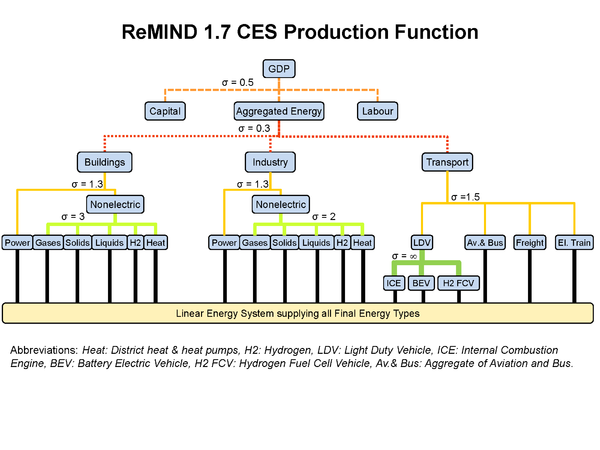Production system and representation of economic sectors - REMIND-MAgPIE
| Corresponding documentation | |
|---|---|
| Previous versions | |
| Model information | |
| Model link | |
| Institution | Potsdam Institut für Klimafolgenforschung (PIK), Germany, https://www.pik-potsdam.de. |
| Solution concept | General equilibrium (closed economy)MAgPIE: partial equilibrium model of the agricultural sector; |
| Solution method | OptimizationMAgPIE: cost minimization; |
| Anticipation | |
REMIND-MAgPIE uses a nested production function with constant elasticity of substitution (CES) to determine a region’s gross domestic product (GDP) (see <xr id="fig:REMIND-MAgPIE_4"/> bleow). Inputs at the upper level of the production function include labor, capital, and final energy. We use the population at working age to determine labor. Final energy input to the upper production level forms a CES nest, which comprises energy for transportation and stationary energy coupled with a substitution elasticity of 0.3. In turn, these two energy types are determined by the nested CES functions of more specific final energy carriers. REMIND-MAgPIE assumes substitution elasticities between 1.5 and 3 for the lower levels of the CES nest. It assigns an efficiency parameter to each production factor in the various macroeconomic CES functions. The changes of efficiency parameters over time are tuned such that baseline economic growth and energy intensity improvements match exogenous scenario specifications, such as the shared socio-economic pathways SSP [1].
<figure id="fig:REMIND-MAgPIE_4">
 </figure>
</figure>
Figure 1. Production structure of REMIND-MAgPIE. Linear production functions describe the conversion of primary energy (lowest level) to final energy carriers. Nested CES structures describe the aggregation of final energy carriers for end-use.
The macro-economic budget constraint for each region ensures that, in each region and for every time step, the sum of GDP Y(r,t) and imports of composite goods M_G(r,t) can be spent on consumption C(r,t), investments into the macroeconomic capital stock I(r,t), energy system expenditures E(r,t) and the export of composite goods X_G(r,t). Energy system expenditures consist of investment costs, fuel costs, and operation and maintenance costs.
The balance of demand from the macro-economy and supply from the energy system delivers equilibrium prices at the final energy level. Macroeconomic capital depreciates at 5% per year, and investments are subject to adjustment costs that scale with the square of the rate of change in investments relative to the capital stock.
- ↑ O’Neill BC, Kriegler E, Riahi K, et al (2014) A new scenario framework for climate change research: the concept of shared socioeconomic pathways. Climatic Change 122:387–400. doi: 10.1007/s10584-013-0905-2